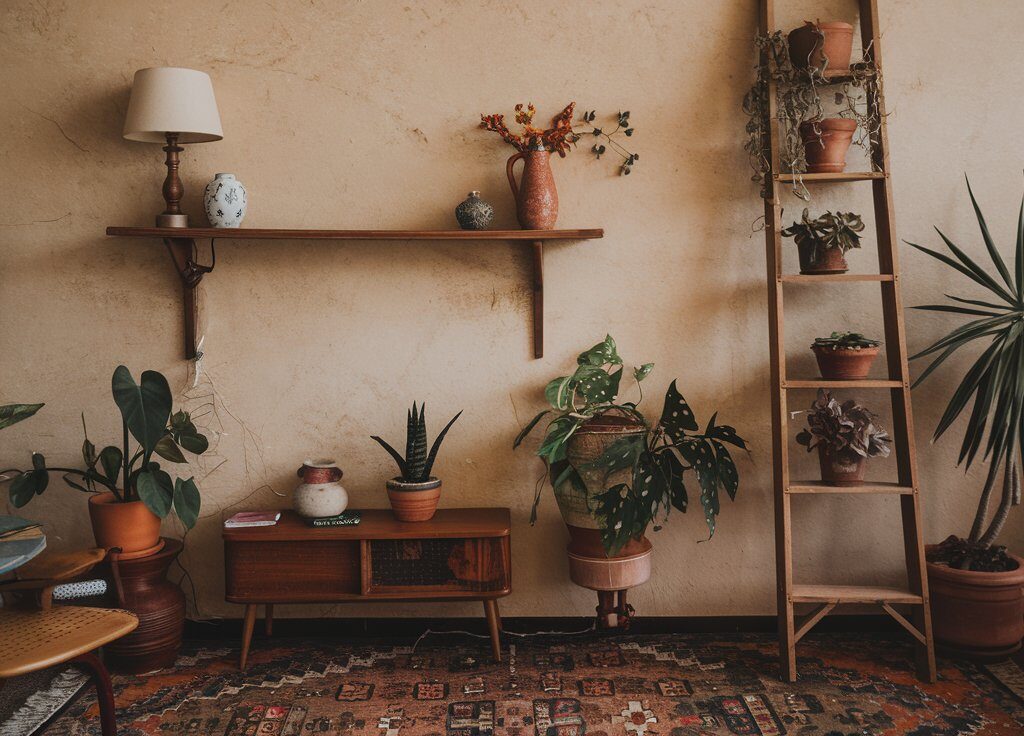Small farmhouse design is captivating homeowners with its unique blend of rustic warmth and modern simplicity. This popular style emphasizes cozy spaces that maximize both comfort and functionality, perfect for those who cherish charm without sacrificing practicality. Think exposed beams, reclaimed wood accents, vintage decor, and spaces that feel lived-in yet uncluttered.
Whether you’re transforming a tiny room or planning a full home renovation, incorporating small farmhouse design elements can create a welcoming, timeless atmosphere that embodies simplicity and elegance. Embrace trends such as multi-functional furniture, open shelving, and soothing neutral palettes that make your space feel airy and inviting. With a few key changes, your home can exude the signature coziness of the farmhouse aesthetic, no matter the size. Dive into these design ideas to turn your small space into a perfect blend of modern comfort and country charm.
1. Embracing Modern Farmhouse Minimalism
Minimalism is making a significant mark in small farmhouse design. This trend strips away excess and focuses on clean, straightforward lines that make a space feel open and uncluttered. Modern farmhouse minimalism blends sleek, contemporary elements with rustic touches, creating an inviting yet straightforward look. For example, opting for a simple wooden dining table paired with white chairs or using neutral tones like whites, beiges, and soft grays can enhance the serene ambiance of a small home.

Key Features of Minimalist Small Farmhouse Design
To create a minimalist aesthetic, choose furniture that has dual purposes, like a storage bench or an ottoman that doubles as a coffee table. The key is to use decor sparingly; a single vase with fresh greenery or a set of woven baskets can provide the farmhouse touch without cluttering the space. Keep walls bare or adorned with minimal artwork, such as a single framed black-and-white print.
Tips to Maintain a Minimalist Aesthetic
Stick to one or two main focal points in a room to avoid over-decorating. Using natural materials, like exposed wood and metal fixtures, can give your home character without making it feel busy. Keeping a balance of open space and carefully chosen pieces ensures the room remains airy and inviting.
2. Rustic Touches for Authenticity
Rustic elements are a cornerstone of small farmhouse design. Integrating features like reclaimed wood, vintage decor, and distressed finishes brings warmth and authenticity to any space. This trend honors the farmhouse roots while adding a unique, lived-in feel that makes a home truly special.

Using Reclaimed Wood and Vintage Decor
Incorporating reclaimed wood—whether through exposed ceiling beams, a dining table, or shelves—adds texture and history to a room. Vintage decor, such as old clocks, lanterns, or handwoven rugs, provides an additional layer of charm. These details make a small space feel cozy and full of character.
Balancing Rustic and Modern Elements
To prevent a room from feeling overly old-fashioned, balance rustic touches with contemporary pieces. For instance, pair a reclaimed wood dining table with modern chairs or add an industrial-style pendant light above it. This blend ensures your space remains fresh while showcasing farmhouse tradition.
3. Open-Concept Living Spaces
The concept of open living spaces is crucial in modern small farmhouse design. It helps maximize natural light and creates an airy atmosphere that makes even a small area feel spacious. The open-concept layout combines the kitchen, dining, and living areas seamlessly, fostering connection and flow within the home.

Maximizing Space in a Small Farmhouse
When embracing an open-concept layout, use furniture placement to define separate areas without walls. For example, a couch can act as a divider between the living and dining space. Use light-colored walls and large windows to enhance the feeling of openness.
Benefits of an Open-Concept Layout
This layout style promotes easier movement and better communication among family members. It also allows for multifunctional use of spaces, perfect for entertaining or adapting to the changing needs of a household. An open-concept design invites flexibility, making small homes more versatile and enjoyable.
4. Cozy and Inviting Textures
Textures are essential to achieving a welcoming and warm farmhouse ambiance. They make a space feel layered and rich, contributing to the cozy factor that’s a staple in small farmhouse design.

Layering with Natural Fabrics
To create this inviting feel, use natural fabrics like linen, cotton, and wool. Drape a soft, neutral-colored throw over a sofa or add a few knitted cushions to a reading nook. Curtains made of sheer, light linen can also soften a room while still allowing in ample light.
Incorporating Cozy Accents like Throws and Cushions
Small touches such as woven rugs, fringed throw blankets, and decorative pillows with farmhouse motifs add depth and warmth. The goal is to create a comfortable space that feels like a peaceful retreat from daily life.
5. Farmhouse Lighting Trends
Lighting is an often-overlooked aspect of small farmhouse design, yet it plays a crucial role in defining the overall ambiance of a space. The right lighting can transform a room, adding both function and aesthetic appeal.
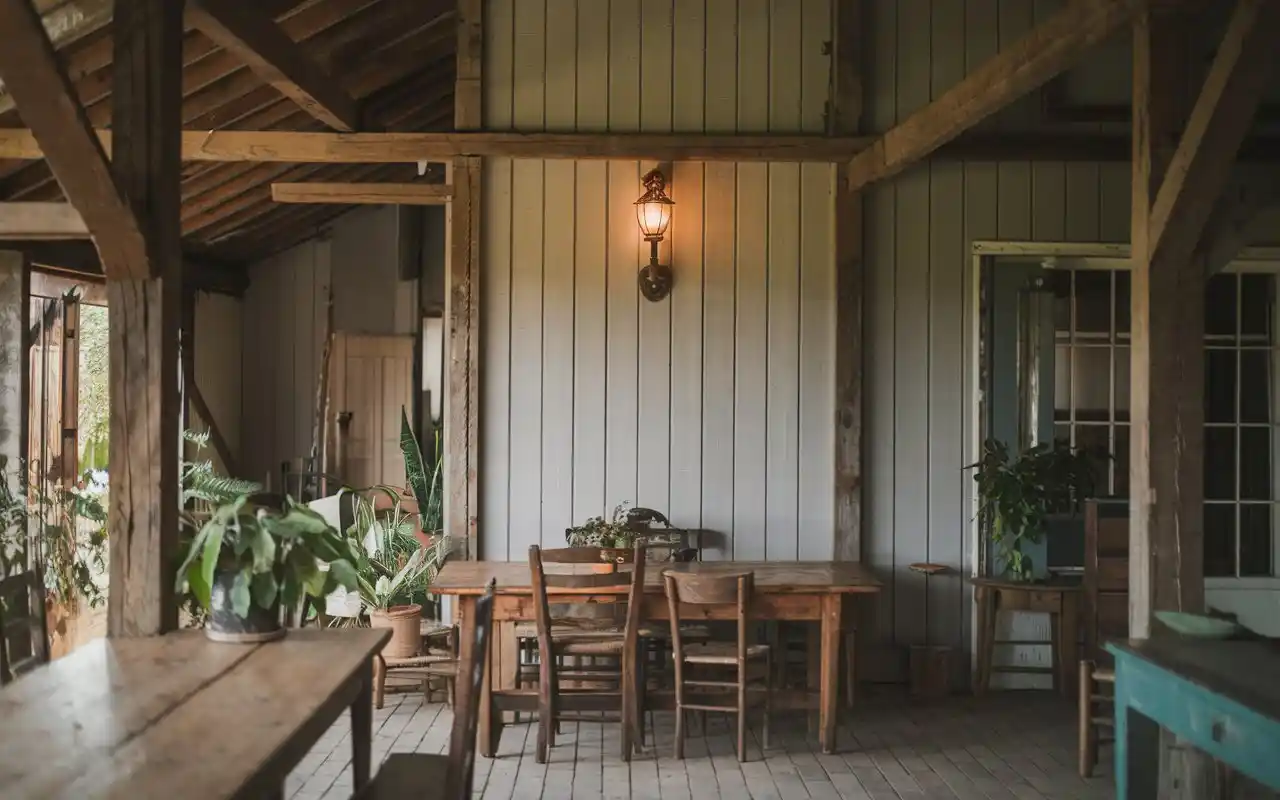
Choosing the Right Lighting Fixtures
Opt for pendant lights, wrought-iron chandeliers, or vintage-style sconces that exude farmhouse charm. These fixtures serve as statement pieces that tie the room together. Natural materials like wood or metal are perfect for enhancing the rustic feel while maintaining modern elegance.
Incorporating Natural Light
Maximize the use of natural light by positioning mirrors strategically and using light, sheer curtains. Skylights or large windows that allow sunlight to flood in can make a small space feel larger and more welcoming.
6. Warm, Earthy Color Palettes
One of the defining characteristics of small farmhouse design is its warm, earthy color scheme. Colors inspired by nature—think soft whites, creams, muted greens, and warm browns—contribute to a serene, grounded atmosphere.
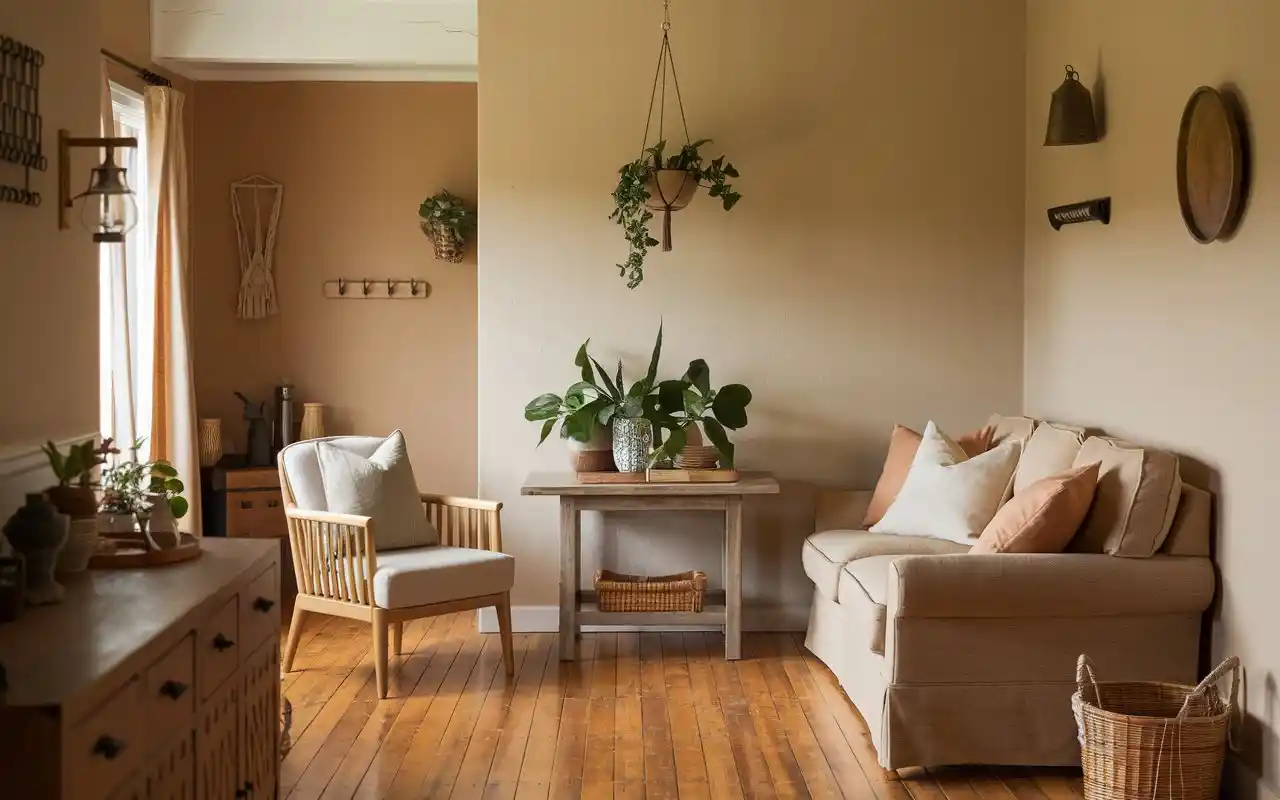
Popular Color Choices for Small Farmhouses
Opt for paint colors like soft beige or taupe for walls and use darker accents such as charcoal or deep green for trim or furniture. Wooden floors or exposed brick add to the natural, rustic appeal. These hues create a calming backdrop that pairs well with both vintage and modern farmhouse elements.
Tips for Mixing and Matching Hues
To add depth, mix lighter base tones with darker, richer colors through accessories like area rugs, artwork, or decorative pieces. For a cohesive look, repeat the accent color in at least three different elements throughout the room.
7. Sustainable and Eco-Friendly Design
In today’s world, sustainability has moved beyond being a trend – it’s now a necessity. Small farmhouse design lends itself well to eco-friendly practices, incorporating recycled materials and sustainable building techniques.

Utilizing Recycled Materials
Reclaimed wood furniture, recycled metal fixtures, and vintage decor can be repurposed to reduce waste and give your home an eco-conscious touch. Even small changes like using bamboo or jute rugs can contribute to a greener home.
Energy-Efficient Design Choices
Consider energy-efficient windows, LED lighting, and appliances that are rated for low energy use. These choices not only reduce environmental impact but also lead to cost savings on utility bills.
8. Statement Furniture and Decor Pieces
While minimalism is a staple of small farmhouse design, the inclusion of bold statement pieces can elevate a space and make it memorable.
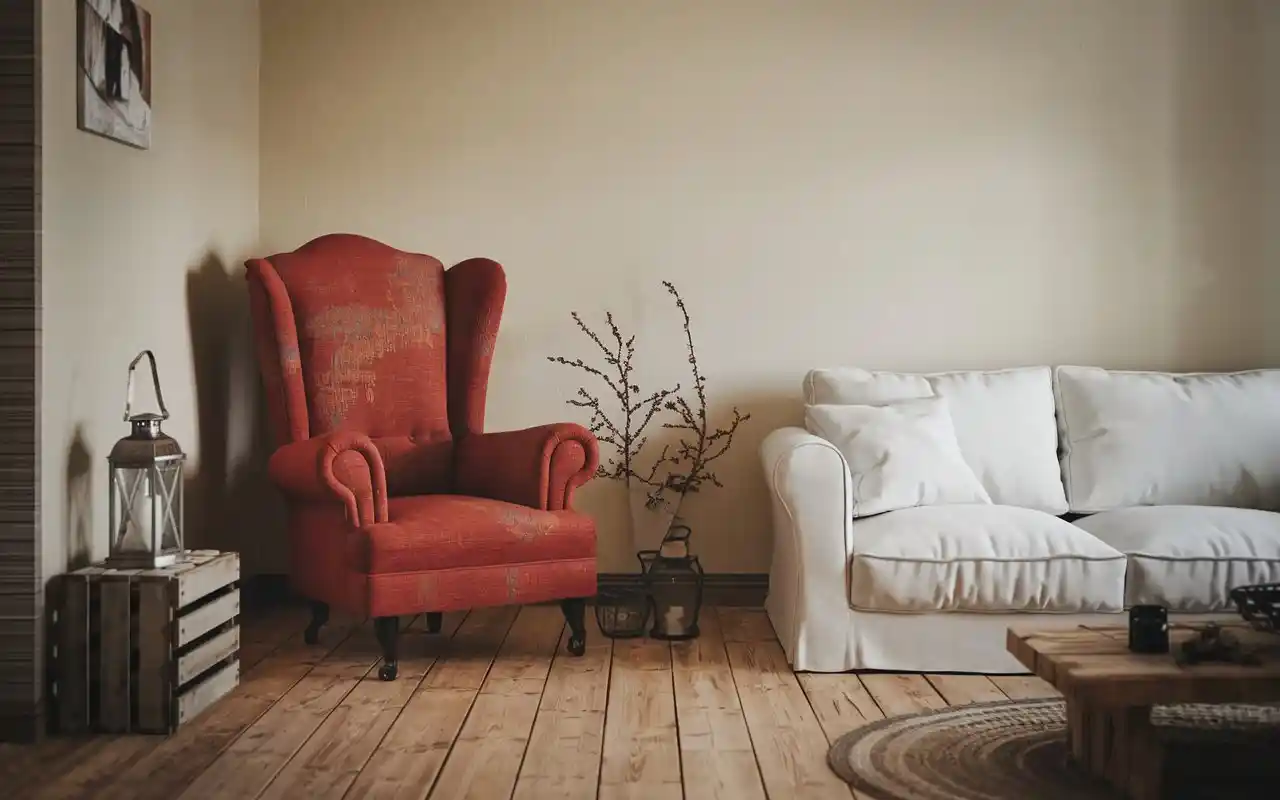
Incorporating Bold Pieces While Keeping Cohesion
Consider adding an antique farmhouse table as a focal point in the dining area or a bold, vintage-style armchair in the living room. These pieces should be eye-catching but harmonious with the rest of the decor.
Finding the Right Balance with Small Spaces
The key is to balance statement items with more subtle, supportive elements. For instance, if you have a bold, rustic dining table, keep the surrounding chairs simple and neutral.
9. Multi-Functional Spaces for Practical Living
Small homes need to make the most of every square foot. In small farmhouse design, creating multi-functional spaces helps maintain a balance between style and practicality. This approach maximizes usability without compromising on aesthetics.
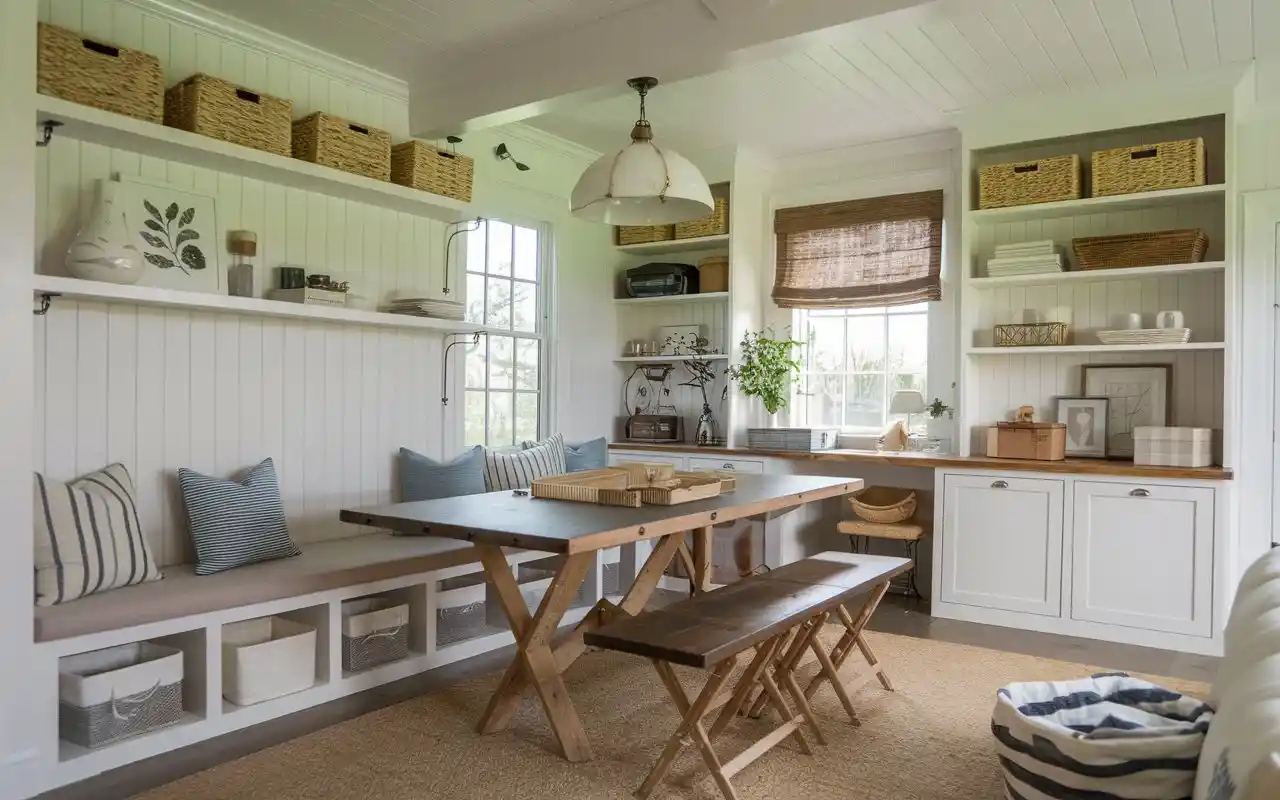
Designing Multi-Functional Areas
Incorporate furniture that serves dual purposes. For example, a bench with storage underneath or a dining table that can also be used as a workspace. Foldable or extendable tables and built-in shelves can provide additional storage and functionality, crucial for compact spaces.
Tips for Seamless Integration
Ensure that multi-functional pieces blend with the overall decor. Choose items that have a rustic or vintage finish to match the farmhouse theme. Use decor such as baskets and fabric bins for extra storage that’s both practical and stylish.
10. Farmhouse Kitchen Trends
The kitchen is the heart of the home, and in small farmhouse design, it’s all about blending charm with modern functionality. These kitchens often feature a combination of rustic materials and practical layouts.
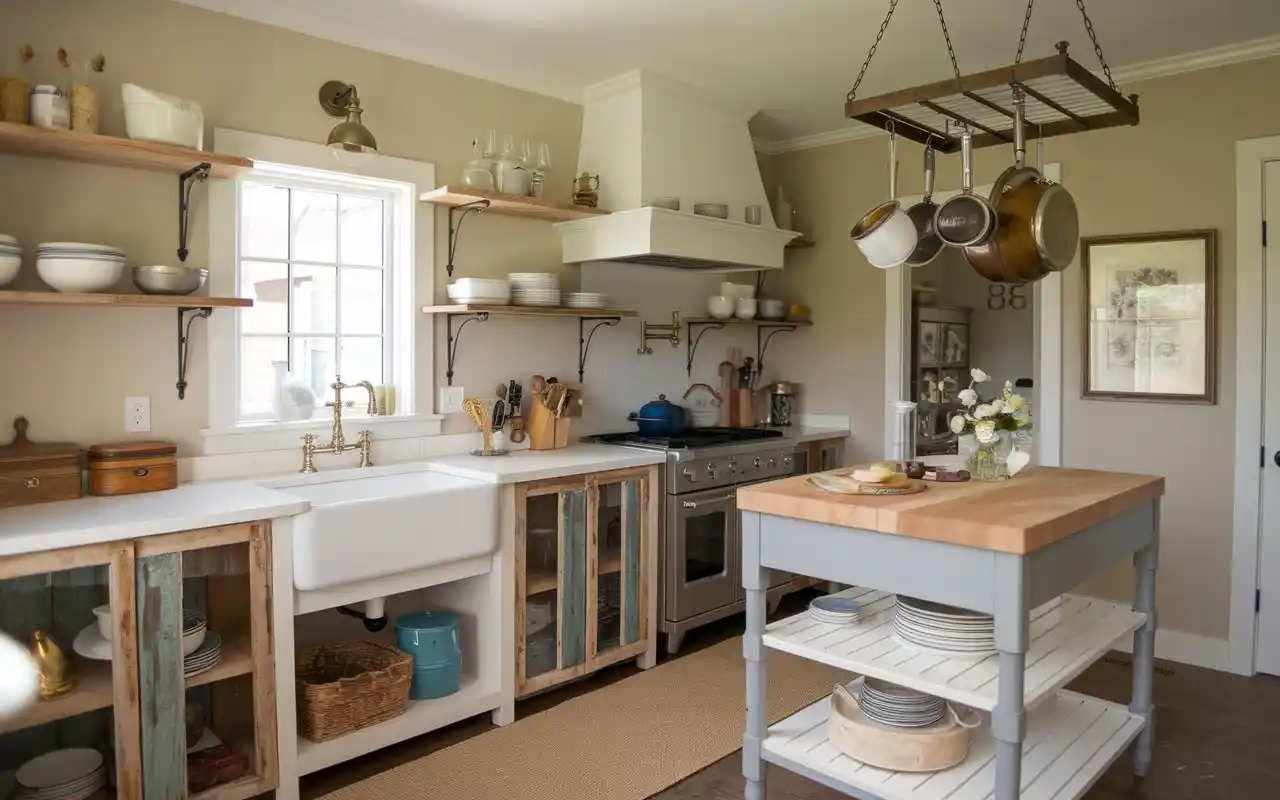
Signature Elements of a Farmhouse Kitchen
Look for open shelving made from reclaimed wood, farmhouse sinks, and vintage-style faucets. These details add authenticity and practicality. A kitchen island with a butcher block top or open cabinets showcasing dishes and jars is another popular feature.
Maximizing Small Kitchen Spaces
Optimize space with smart storage solutions like hanging pot racks or vertical spice shelves. Keep countertops clear by storing items in labeled glass jars or wooden containers. A balance of open and closed storage helps maintain an uncluttered look while adding to the farmhouse charm.
11. Farmhouse-Inspired Bathroom Details
Bathrooms in small farmhouse design are not only functional but also inviting. They incorporate natural materials and warm details that transform them into serene spaces.

Key Features to Include
Farmhouse bathrooms often have features like shiplap walls, brass or bronze fixtures, and vintage vanities. Small decorative touches such as mason jar containers for toiletries and rustic wood-framed mirrors can create the perfect balance of charm and utility.
Design Tips for Small Bathrooms
For smaller spaces, use light colors and large tiles to make the room feel more spacious. Consider installing floating shelves for storage and choosing glass shower enclosures to avoid visual clutter. These elements help to keep the space open while maintaining the farmhouse theme.
12. Outdoor Spaces with Farmhouse Appeal
Small farmhouse design doesn’t stop at the interior—it extends to outdoor areas as well. Creating cozy, functional outdoor spaces is essential for enhancing the overall farmhouse aesthetic.

Designing a Farmhouse Porch or Patio
A farmhouse-style porch can include rustic wooden rocking chairs, a swing bench, or planters made from repurposed metal buckets. Use lanterns or string lights to provide soft, ambient lighting that makes the space inviting at night.
Incorporating Nature
Enhance the outdoor space with natural elements like a small herb garden, potted flowers, or a climbing plant trellis. These details bring the warmth of the farmhouse style to your outdoor living area and provide a seamless connection with nature.
13. Flooring Choices for Farmhouse Style
Flooring is another important element in small farmhouse design. It sets the tone for the entire room and should complement the overall aesthetic.
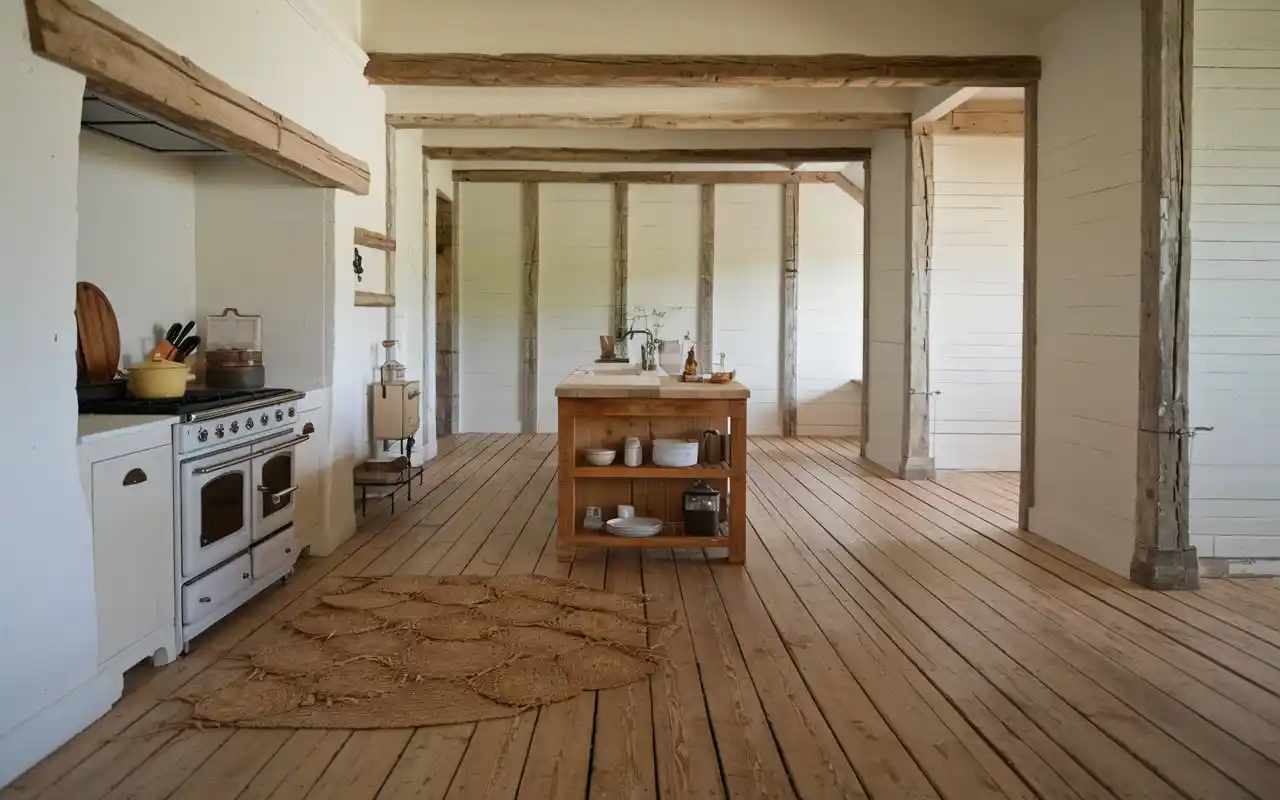
Popular Flooring Options
Wooden floors are a classic choice for farmhouse design, often featuring wide planks or distressed finishes. If real wood isn’t practical, consider laminate or vinyl that mimics the look of wood. For added warmth and texture, layer area rugs made from natural fibers.
Low-Maintenance Alternatives
For high-traffic areas or families with pets, opt for durable options like porcelain tiles that replicate the look of wood. These tiles are easy to clean and maintain while offering the same farmhouse charm.
14. Farmhouse Decor Essentials
Incorporating the right decor is key to perfecting small farmhouse design. The decor should blend seamlessly with the rest of the home while reflecting your personal style.
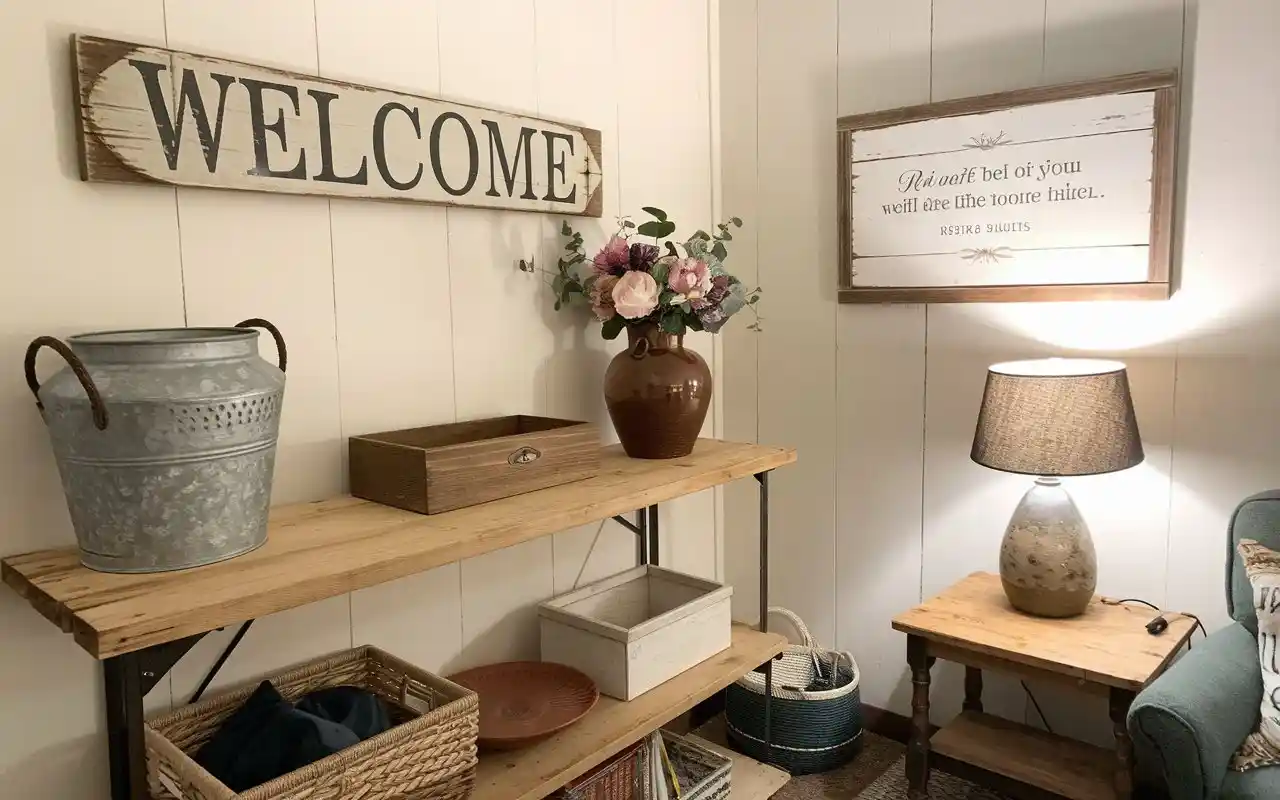
Must-Have Decor Items
Popular farmhouse decor choices include woven baskets, galvanized metal accents, vintage signs, and wooden picture frames. Candles, ceramic vases, and simple wall art with quotes or rustic motifs can also enhance the ambiance.
Tips for Decorating Small Spaces
Keep decor minimal to avoid overcrowding. A few statement pieces, like a large clock or a decorative ladder with blankets, can make a big impact without taking up valuable space. The goal is to achieve a balance that feels both styled and lived-in.
15. Adding a Modern Twist
Blending contemporary touches with traditional farmhouse elements is a growing trend in small farmhouse design. This combination keeps the design fresh and prevents it from feeling dated.
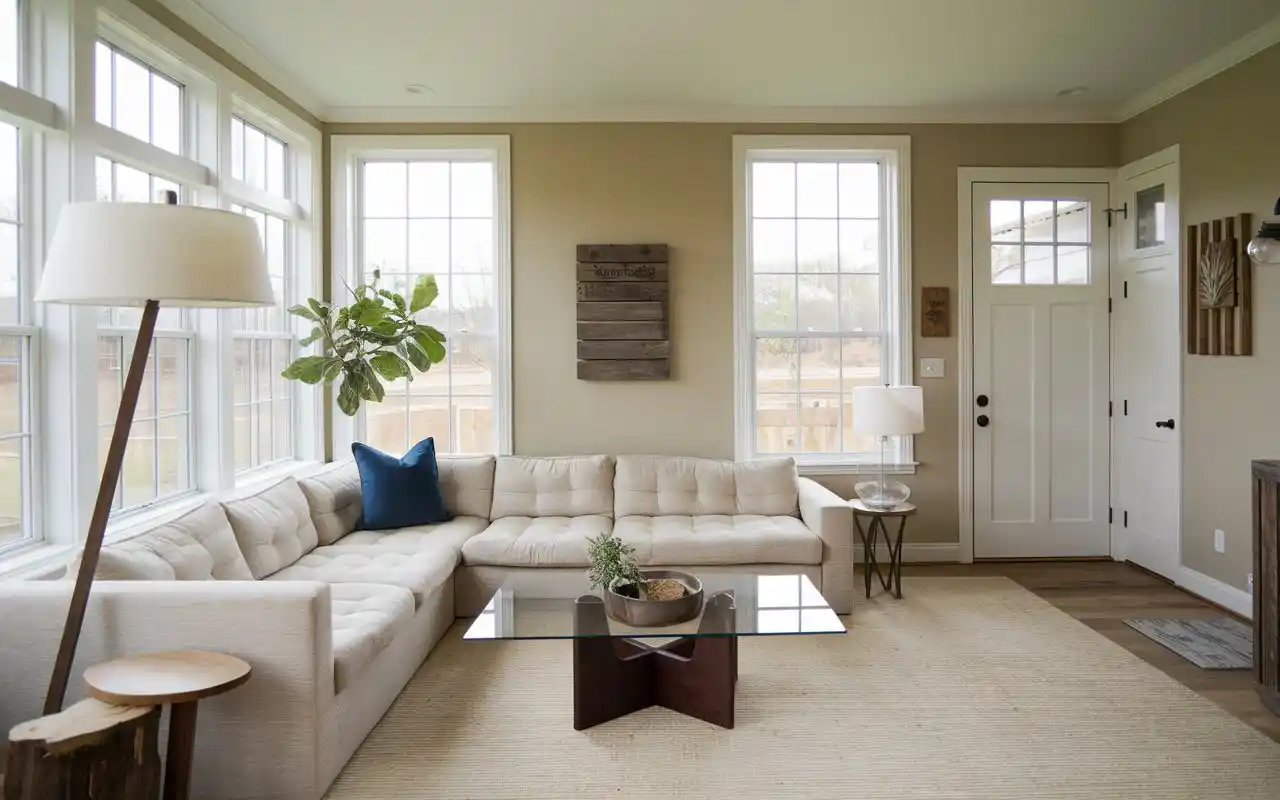
Modern Elements to Integrate
Consider incorporating modern furniture with clean lines and geometric shapes or adding pops of color through decor. Minimalist pendant lighting and sleek hardware on cabinets provide subtle modern touches.
Keeping the Farmhouse Vibe Intact
Even with modern elements, it’s important to maintain the cozy, welcoming feel of the farmhouse style. Achieve this by keeping a mix of modern and rustic, ensuring neither style overshadows the other. This balance helps you create a unique space that feels timeless and fresh.
Conclusion
Incorporating small farmhouse design into your home allows you to create a cozy, inviting space full of character and warmth. This design style blends rustic charm with practical elegance. It makes even small spaces feel larger and more welcoming. You can effortlessly transform your home by choosing key elements such as reclaimed wood accents, neutral color palettes, and vintage-inspired decor and updating your kitchen, living room, or outdoor area? Small farmhouse design adds timeless comfort and style. Start using these trends today. You’ll find a perfect mix of modern convenience and country charm in your home.


